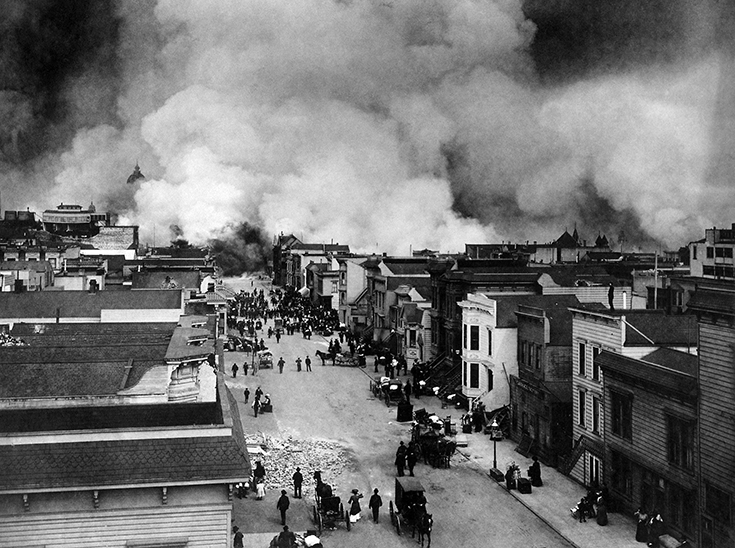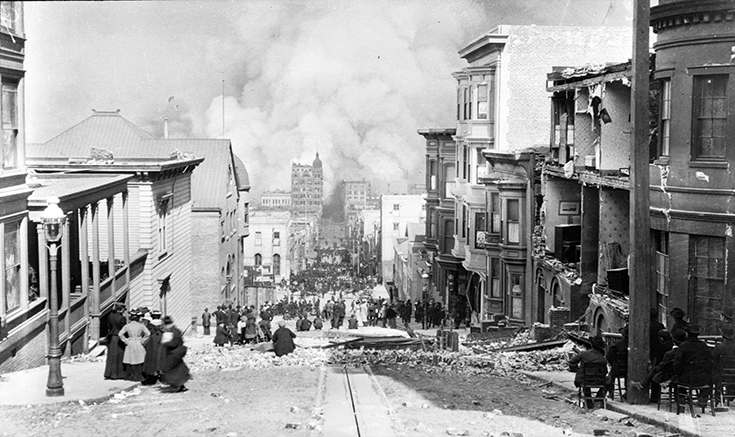Earthquake lessons still hold true today
Jay Levinson and Abraham ‘Avi’ Domb say that more than 100 years after the San Francisco earthquake of 1906, many of the issues the city experienced are still relevant today

Fire – with temperatures that melted metal – swept through San Francisco after the earthquake (photo: Chadwick, HD/US Gov War Department, Office of the Chief Signal Officer/NARA National Archives and Records Administration)
More than 100 years have passed since the San Francisco earthquake of 1906. In that time response technology has progressed significantly, but some of the issues confronting the destroyed city still are relevant today.
Ed Gleeson, a young reporter for the city’s Daily News, was witness to some of the post-earthquake pandemonium that struck the city. Only one newspaper survived the intense fire that ensued. As Gleeson described: “It would be like trying to reduce Hell to a single paragraph.” Another newspaper, before being forced to shut down, was incredulous and totally minimised the situation.
Fire followed the earthquake, with temperatures that melted metal. Gas lines were ruptured, buildings collapsed and water mains broke, rendering traditional firefighting useless. In moments the disaster outstripped response capabilities. Hundreds if not thousands lay dead, awaiting identification.

Looking towards the fire on Sacramento Street, San Francisco, 1906 (photo: Arnold Genthe - Library of Congress)
A key to any response, whether one hundred years ago or today, is an accurate assessment of the situation. And this was missing during this incident. Just as the Chicago fire did not start with Mrs. O’Leary’s legendary cow, it took time to squash the rumour that the San Francisco fires had been the result of a cooking accident.
Operational control was problematic as city government was clearly unprepared. Some contend that officials were more interested in graft and payoffs than in running the city. Be that true or not, the senior local military officer saw weak civilian officials and assumed command of the response without proper legal authorisation. In retrospect, we are not in a position to enter into a judicial debate. It can only be said that that the military officer provided strong and decisive leadership at a time of need (including summary execution of looters – and there definitely was at least attempted looting).
Wealth does not protect. Enrico Caruso, the famous opera tenor, had performed in the city the previous evening. He was formally dressed in striped trousers, enjoying bacon and eggs for breakfast in the dining room of the city’s finest hotel two hours after the initial earthquake, oblivious to imminent danger. Caruso eventually and hesitantly evacuated the hotel (with his extensive wardrobe, of course). Soon the hotel would be charred rubble. A general lesson is that buildings and neighbourhoods previously thought to be safe proved to be vulnerable to the flames.
There was not just one earthquake. As is often the case, there were aftershocks, some quite deadly. In planning today this still must be taken into consideration.
How do people react to an earthquake? Perhaps irrationally, many people place a distorted importance on property. Enrico Caruso was concerned with his performance clothing. Others fled the disaster with possessions ranging from sentimental pictures and cherished jewellery, to blankets and mattresses. Today the concerns are not that different. There are numerous examples of people loading down cars and vans before they vacate their homes, no matter how imminent the danger.
Fire was not the only hazard confronting San Francisco. In one rural area a landslide generated by the earthquake buried a mill, along with its workers. This raises the very pragmatic question of how to field the limited number of available response and rescue workers.
One asylum for mentally problematic patients, who could not care for themselves, was badly affected in that potential caretakers could not be found, nor were there any alternative appropriate facilities to house the patients.
Another population posed a similar problem in that a prison had to be evacuated. Those incarcerated who could be saved were marched out of the prison under the supervision of soldiers, bayonets in hand.
Hospitals were also a problem and not one single hospital in the city was left entirely intact. Not only were buildings affected, as medical staff had been killed or suffered serious injury.
At least one ship at sea suffered from a tsunami caused by the earthquake.
This is not a ‘what if’ disaster exercise dreamt up by an imaginative bureaucrat. It is a description of an earthquake that really happened. The events cannot be dismissed as: “That was more than one hundred years ago.” The solutions might be passé, but the basic planning and response problems still confront us today.
Jay Levinson, Abraham Domb, 14/05/2017